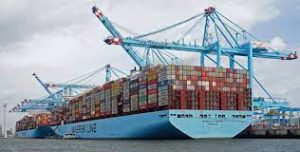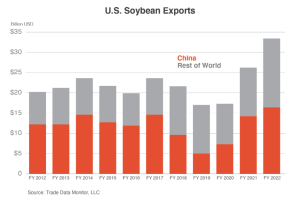

The relationship between the US and China remains a current topic in many circles. Since the beginning of 2023, two US officials, Secretary of State Antony Blinken and US Treasury Secretary Janet Yellen, have met with Chinese officials to warm the relationship between the two countries.
Over the past 50+ years, the US-China trade relationship has undergone significant transformation, evolving into one of the most consequential economic partnerships in the world. Agriculture has been at the center of the relationship, which has seen both cooperation and conflicts.
In 1972, when the US and China signed the Shanghai Communique, trade between the two countries was limited. Total trade value was just $95 million USD, with limited quantities and few product categories. Primary products exported to China included soybeans, cotton, wheat, and meat products.
Over the next two and a half decades, trade with China rose consistently. And in 2000, Congress passed, and President Clinton signed what’s known as ‘most favored nation’ trade status, or permanent normal trade relations with China, giving them the same access to American markets as other U.S. trading partners. This trade status paved the way for China’s entry into the World Trade Organization (WTO), and facilitated an explosion of trade between the US and China.
Soybeans have been a critical export for a growing Chinese middle-class population, with different dietary preferences than previous generations. According to the Federal Reserve Bank of St. Louis, the value of soybean exports to China climbed from around 19 percent of global U.S. soybean exports in 2001 to around 57 percent in 2017.

In FY 2022, soybeans accounted for nearly one-half of US ag exports to China, representing $16.4 billion. Today, China is the world’s largest importer of soybeans, accounting for nearly 60 percent of global trade, and one-half of US soybean export value.
Additional US ag exports to China include, among other things, corn ($4.8B), cotton ($2.7B), sorghum (~$2.2B), beef ($2.1B), pork ($1.1B), and poultry ($1.1B).
These stats alone show how valuable agriculture is to the US-China relationship. It’s important to my bottom line, as well as the balance sheets of many American farmers.
Agriculture trade, and US ag production, is equally important to the Chinese. The FAO describes China as having a long history of agriculture production with steady progress in using its limited arable land for growing crops. There is no feasible way China can feed its citizens on the limited amount of land available for growing crops.
China needs the crops we produce to meet the food demands of its growing population, which is expected to reach 1.52 billion in just six short years. And while India will overtake China as the world’s most populous nation by 2030, that doesn’t erase China’s need for our agricultural products.
We must continue talking with the Chinese, bringing them to the table for constructive conversations about our relationship. And the value to both sides of the relationship.
